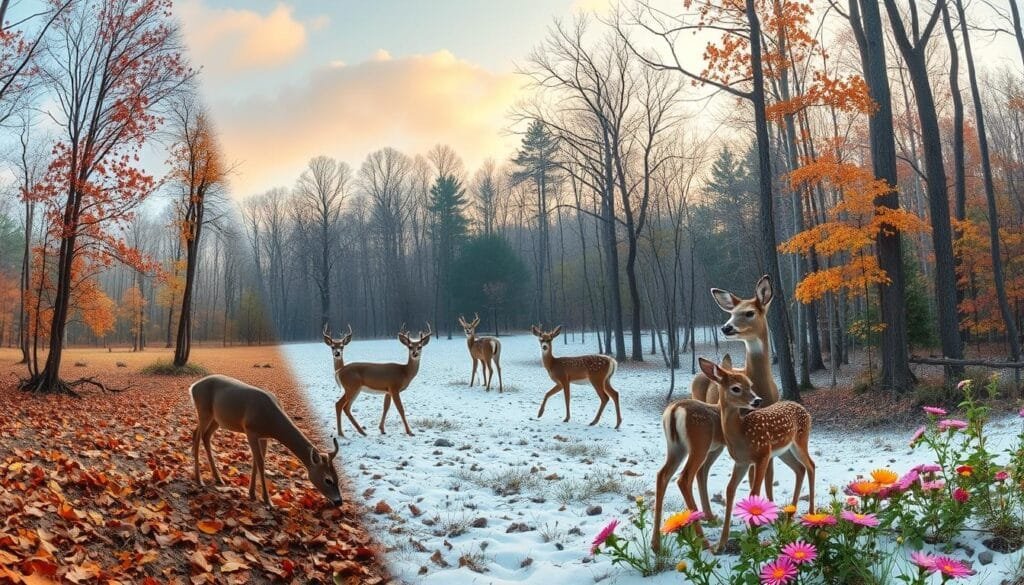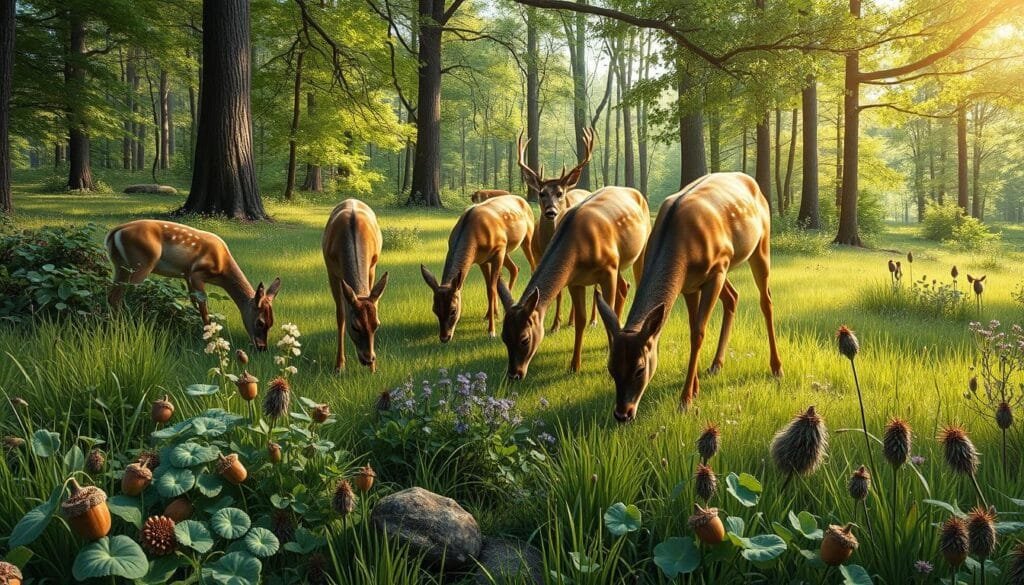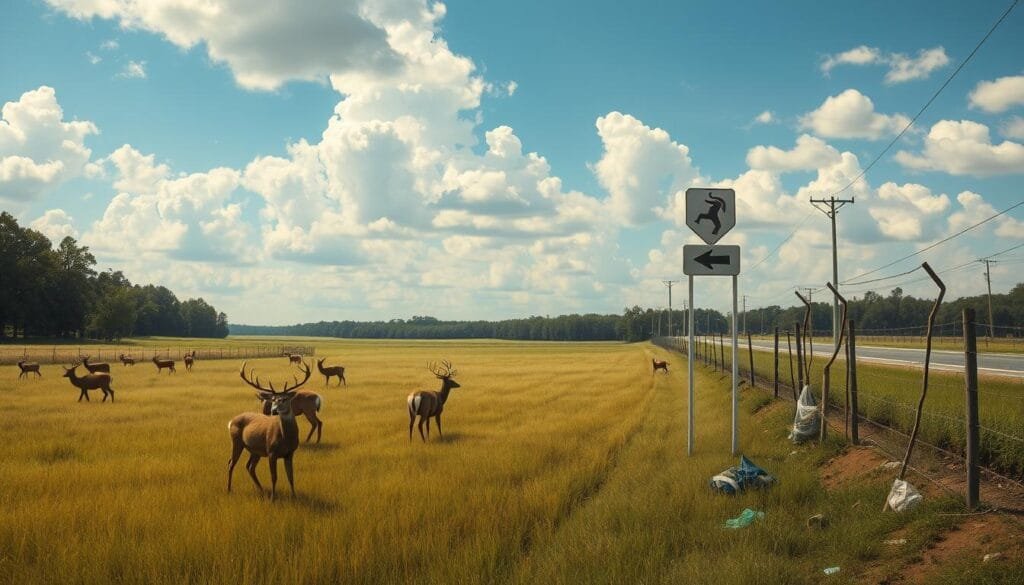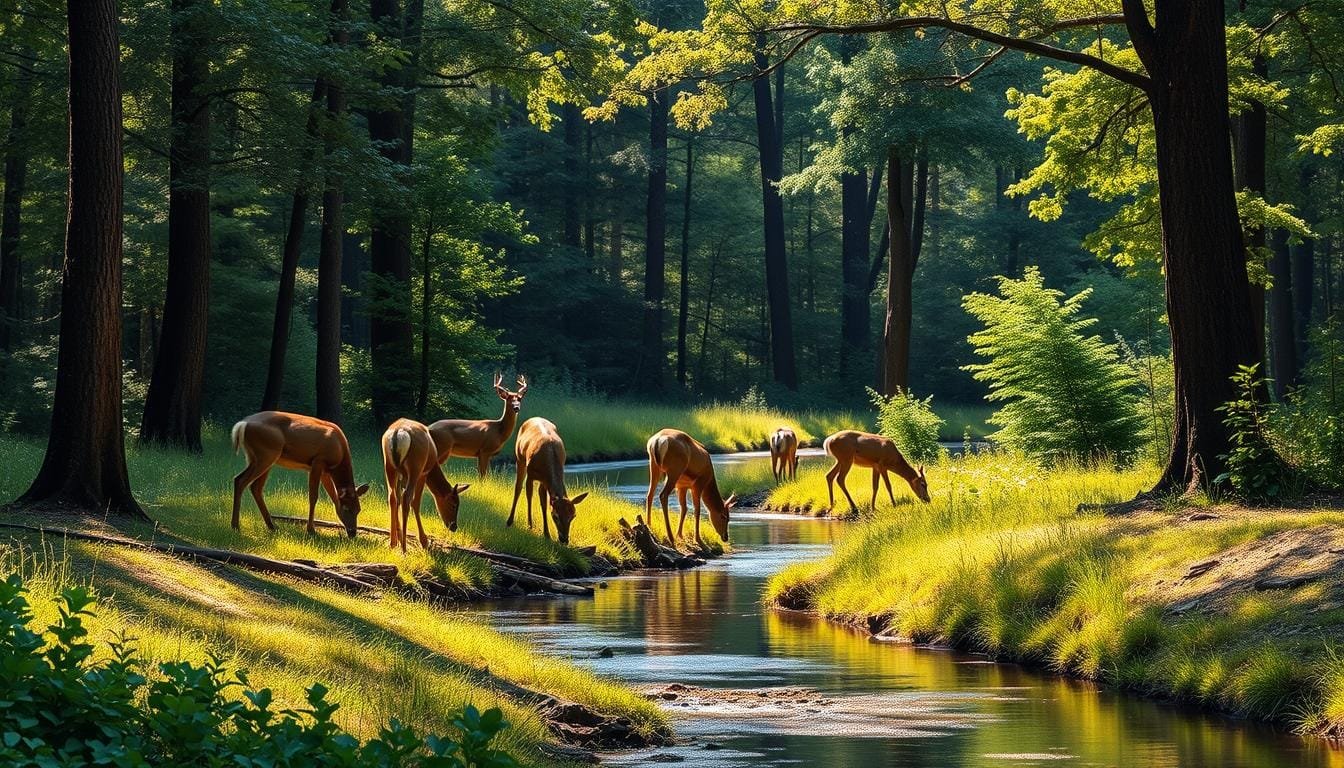Georgia’s landscapes are a perfect home for deer. They show us an amazing mix of behaviors and activities. These are vital for their survival and reproduction. Knowing about Georgia deer helps us understand their habits and life. We get to see what influences their home, changes through the seasons, and how they interact with their world and us.
Key Takeaways
- Deer in Georgia have adapted behaviorally to their home range, largely influenced by food, cover, and water availability.
- Core areas within a deer’s home range represent significant locations like bedding and feeding spots.
- The size of a whitetail deer’s home range can vary depending on habitat quality and regional factors.
- Seasonal shifts prompt deer to adjust their movements and diet changes during different times of the year.
- Human activities, especially hunting pressure, notably affect deer behavior and movement patterns.
Understanding the Home Range of Georgia Deer
The area that a deer calls its home throughout the year is its home range. It’s key to know this to grasp how they live and move in Georgia. Each deer has its own way of life that affects its home range size and nature. The availability of food, water, and shelter play a big role in shaping these ranges.
What is Home Range?
A deer’s home range is where it spends its days. It’s shaped more by nature than any neat pattern we can imagine. Generally, in Georgia, a deer’s home range is about 650 acres, but it can change. We see adult bucks roam over a mile yearly, and these areas vary over time.
Core Areas vs. Home Range
Deer have what’s called core areas within their home range. These spots, usually 50 to 75 acres in size, are key for their feeding, resting, and safe nesting. This is different from the larger home range and shows where deer focus their daily life for survival.
Factors Influencing Home Range
Many things impact where and how big a deer’s home range is. The main ones are food, water, and where they can rest safely. Also, the threat from predators, changes in seasons, and human activities affect them. For example, in colder places, deer might travel more. And in tough winters, they often stay in places called winter yards, with trees like conifers for cover. This shows how deer adapt to survive.
| Factor | Impact on Home Range |
|---|---|
| Food Availability | Influences the size and location due to necessary resources for survival. |
| Water Availability | Determines core areas where deer spend most of their time. |
| Bedding Cover | Provides shelter, influencing core areas within the home range. |
| Predatory Pressure | May cause shifts in home range for safety. |
| Seasonal Changes | Results in movement between summer and winter ranges. |
Seasonal Shifts in Deer Behavior
Tracking or hunting deer requires knowledge of their seasonal movements. Deer adapt their behavior to the changing seasons. This includes changes due to weather, food sources, and mating seasons.
Spring and Summer Movements
In spring and summer, deer focus on eating and caring for their young. White-tailed deer need to eat a lot of green plants to stay healthy. They eat 6% to 8% of their body weight daily during these months. With plenty of food available, deer stay in areas with a lot of vegetation and safety. This time is also when fawns are born. Does stay close to their fawns to protect them.

Fall and Winter Activities
In fall, deer behavior changes as they get ready for mating season, known as the rut. Bucks become more active, looking for mates. Deer activity increases a lot just before and after the full moon. Also, cool weather makes deer more active. For instance, more deer are seen on cool October and November days than in warmer weather. Most mature bucks are taken when the temperature is 50 degrees Fahrenheit or below.
Winter demands a diet high in fat and carbs for deer. They need this to maintain their energy. Weather strongly affects where deer go in winter. A sudden cold snap after rain can make deer more active. But, warmer weather may cause them to be active at night.
Learning about how deer behavior changes with the seasons is key for wildlife fans and hunters. By understanding these patterns, you can better predict where and when to find deer.
What is the Lifestyle Like for a Deer in Georgia?
Studying the lifestyle of deer in Georgia helps us see how they adapt and survive. They have special behaviors for living in various places. Because of this, they continue to thrive in different environments.
Habitat Preferences
Deer in Georgia prefer living in mixed forests and next to farms. These places give them lots of food choices and places to hide. Thick bushes are where they stay safe from predators, especially when they have babies.

Diet and Feeding Habits
Their diet includes leaves, small branches, fruits, and nuts. What they eat changes with the seasons. Acorns are especially important in the fall. This variety in their diet means they can always find something to eat.
Breeding and Reproduction
The deer start looking for mates in late fall, with the most activity in November. Males fight to impress females. Females usually have 1 or 2 babies from May to August, mostly in June. Their ability to have many babies helps their population grow.
Interaction with Predators
Deer need to be careful of predators like coyotes and bobcats, which are dangerous to babies. They are fast and can jump very high to escape. So far, diseases that can harm them greatly haven’t been found in Georgia. This keeps the deer populations healthy.
| Element | Description |
|---|---|
| Habitat | Mixed forests and agricultural lands |
| Diet | Leaves, twigs, fruits, nuts, acorns |
| Breeding | Rutting in late fall, peak birthing in June |
| Predators | Coyotes, bobcats, human-related threats |
Learning about how Georgia’s deer interact with their world shows us their strength. Looking into these matters gives us understanding of how they adapt and sustain balance in their living spaces.
Identifying Deer by Their Physical Characteristics
Identifying deer involves looking at different body traits. In Georgia, the white-tailed deer is the most seen type. Knowing their features helps with correct identification.
Georgia deer vary in size due to their living area and food. An adult white-tailed deer’s weight ranges from 125 to 225 pounds. Some can even reach 250 pounds. They stand up to 45 inches at the shoulder and can be as long as 7 feet.
The clear sign of male deer, or bucks, is their antlers. Bucks use antlers mainly for fighting and during mating season. Antlers can weigh from three to nine pounds. They can grow about half an inch daily. Females, known as does, do not have antlers. This fact is crucial when spotting deer in nature.
The color of Georgia deer is also a key clue. In the summer, their coat is a reddish-brown color. It changes to gray-brown in winter. This change helps them hide better as their surroundings change.
Below is a detailed chart that compares different characteristics of Georgia deer:
| Characteristic | Details |
|---|---|
| Weight | 125 – 250 pounds |
| Height | Up to 45 inches at the shoulder |
| Length | Up to 7 feet |
| Antler Growth | Up to ½ inch per day |
| Coat Color (Summer) | Reddish-brown |
| Coat Color (Winter) | Gray-brown |
Looking at a deer’s physical features is key for hunters and wildlife fans. Knowing these traits helps us recognize Georgia deer right away.
Impact of Human Activity on Deer Behavior
Human activities like hunting and changing their living spaces greatly influence deer in Georgia. We need to grasp these impacts. This understanding ensures we interact with deer in a way that lasts.
Effects of Hunting Pressure
Deer change their numbers and ways of acting when hunting happens. At Red Top Mountain State Park (RTMSP), sharpshooting sharply dropped deer numbers. From 36 deer/km2 in January 2004, it fell to about 10 deer/km2 by March. Studies like this show that well-managed hunting helps control deer numbers. This protects their homes and keeps the ecosystem balanced.
Human actions also up deer deaths, not just through hunting. Before a 2004 study at RTMSP, cars killed nearly 40 deer a year. Thanks to tracking and better safety, no deer were hit during the study. These results show how good management helps people and wildlife live together better.

Deer Adaptations to Human Presence
Deer get creative to live with more people around. They move at night more or hide better to avoid hunters. In RTMSP’s summer of 2004, female deer moved more during human peak times (1400-2000 hours). They’re getting smart about staying safe.
In busy northern Georgia parks from 2018-2020, different factors changed deer behavior. Cars and feeding by visitors, along with predators, made deer adapt. Tracking fawns showed how deer learn to survive in changing conditions. More human contact lowered dangers for fawns at first. But, the risks grow as the environment changes.
| Year | Traffic Volume | Deer Travel Rate (km/hr) |
|---|---|---|
| 2001-2003 | Low | 0.3 |
| 2004 | High | 0.5 |
In the end, more humans affecting deer means we need updated ways to adjust. Changing deer behavior to control their numbers and protect nature is a big challenge. This challenge is key for keeping Georgia’s wildlife safe.
Conclusion
As we wrap up our detailed guide on the Georgia Deer Lifestyle, it’s important to note a few things. First, understanding deer behavior and their homes is key. This knowledge helps us see the vital role deer play in Georgia’s nature.
In Skidaway Island State Park, for example, the land supports around 11.5 deer every year. Deer in Georgia’s islands share similar physical traits. Females weigh about 80 lbs and males about 112 lbs. Human actions greatly influence deer, from hunting to adapting to new environments.
Our study highlights why we must keep studying and protecting deer. With around 18,300 deer hunted each season, sustainable practices matter. By continuing our efforts, we can save deer and live alongside them. Let’s keep working to balance nature with city life.
FAQ
What is Home Range?
The home range is where a deer lives throughout the year. It includes everything they need to survive like food, water, and shelter. In Georgia, scientists use GPS collars to track deer and study their movements.
Core Areas vs. Home Range
The home range is the big area a deer lives in. Core areas are special spots within that range where deer spend most of their time. Deer pick these places for their good food and shelter.
Factors Influencing Home Range
Many things can change a deer’s home range. Food, habitat quality, and predators are key. For instance, Georgia deer might move around based on where they can find food like acorns.
How do deer behavior shift with seasons?
During spring and summer, Georgia deer are busy eating and taking care of their young thanks to the plenty of green plants. When fall and winter come, they switch to foods rich in fat and carbs. This helps them get ready for the cold and the rut.
What are deer habitat preferences in Georgia?
In Georgia, deer like living near forests and farms. These places have the right mix of hiding spots and food, like leaves and fruits, needed for their diet.
What does a Georgia deer’s diet consist of?
Georgia deer mostly eat leaves, twigs, fruits, and nuts. What they eat changes with the seasons. In winter, they look for foods that are high in carbs and fats to stay warm.
How does deer breeding and reproduction work?
Deer get really active during the breeding season. Bucks compete to mate with does during this time known as the rut. They also have to stay safe from predators.
How can you identify deer by their physical characteristics?
To identify deer, look at their size, color, and antlers. In Georgia, you’ll mainly find white-tailed deer. The shape of a deer’s antlers can really stand out, along with size and fur color.
What are the effects of hunting pressure on deer behavior?
Hunting makes deer change their habits. Georgia deer might start moving more at night and hiding in thicker places. This shows how well they can adjust to avoid hunters.
How do deer adapt to human presence?
Deer change their ways when there are more humans around. In Georgia, they might become night wanderers and find denser areas to hide. This helps them stay safe from human threats.
